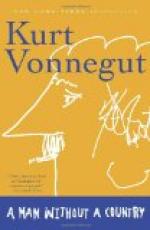The story of Philip Nolan was published in such a crisis that it met the public eye and interest. It met the taste of the patriotic public at the moment. It was copied everywhere without the slightest deference to copyright. It was, by the way, printed much more extensively in England than it was in America. Immediately there began to appear a series of speculations based on what you would have said was an unimportant error of mine. My hero is a purely imaginary character. The critics are right in saying that not only there never was such a man, but there never could have been such a man. But he had to have a name. And the choice of a name in a novel is a matter of essential importance, as it proved to be here.
Now I had a hero who was a young man in 1807. He knew nothing at that time but the valley of the Mississippi River. “He had been educated on a plantation where the finest company was a Spanish officer, or a French merchant from Orleans.” He must therefore have a name familiar to Western people at that time. Well, I remembered that in the preposterous memoirs of General James Wilkinson’s, whenever he had a worse scrape than usual to explain, he would say that the papers were lost when Mr. Nolan was imprisoned or was killed in Texas. This Mr. Nolan, as Wilkinson generally calls him, had been engaged with Wilkinson in some speculations mostly relating to horses. Remembering this, I took the name Nolan for my hero. I made my man the real man’s brother. “He had spent half his youth with an older brother, hunting horses in Texas.” And again:—“he was catching wild horses in Texas with his adventurous cousin.” [Note: Young authors may observe that he is called a brother in one place and a cousin in another, because such slips would take place in a real narrative. Proofreaders do not like them, but they give a plausibility to the story.] I had the impression that Wilkinson’s partner was named Stephen, and as Philip and Stephen were both evangelists in the Bible, I named my man Philip Nolan, on the supposition that the mother who named one son Stephen would name another Philip. It was not for a year after, that, in looking at Wilkinson’s “Memoirs” again, I found to my amazement, not to say my dismay, that Wilkinson’s partner was named Philip Nolan. We had, therefore, two Philip Nolans, one a real historical character, who was murdered by the Spaniards on the 21st of March, 1801, at Waco in Texas; the other a purely imaginary character invented by myself, who appears for the first time on the 23d of September, 1807, at a court-martial at Fort Adams.
I supposed nobody but myself in New England had ever heard of Philip Nolan. But in the Southwest, in Texas and Louisiana, it was but sixty-two years since the Spaniards murdered him. In truth, it was the death of Nolan, the real Philip Nolan, killed by one Spanish governor while he held the safe-conduct of another, which roused that wave of indignation in the Southwest which ended in the independence of Texas. I think the State of Texas would do well, to-day, if it placed the statue of the real Phil Nolan in the Capitol at Washington by the side of that of Sam Houston.




